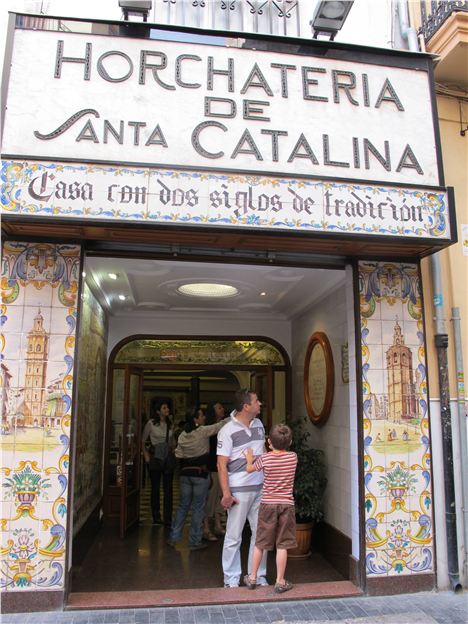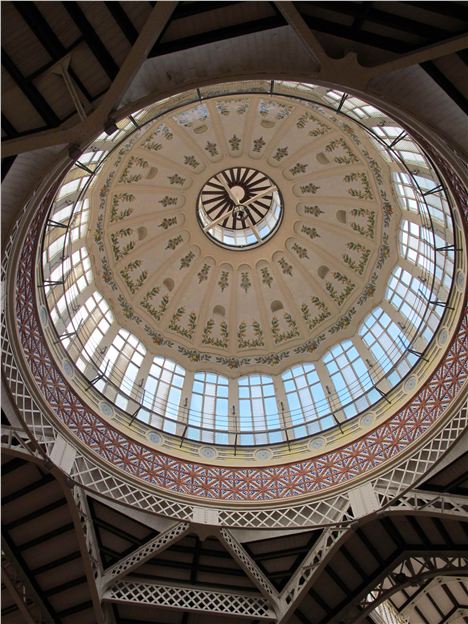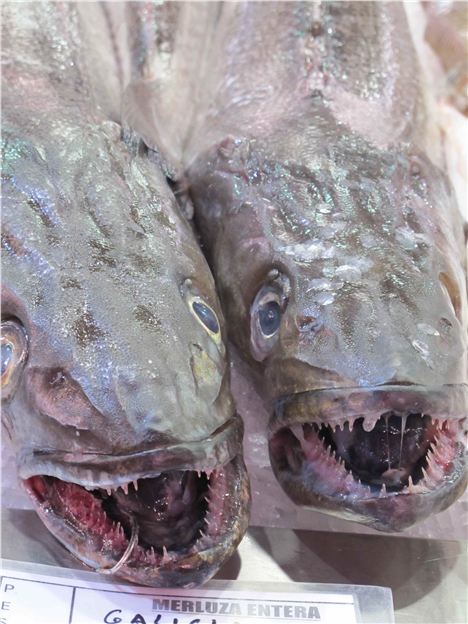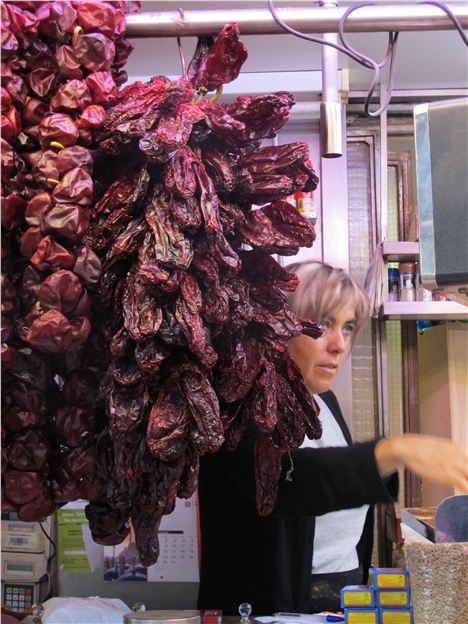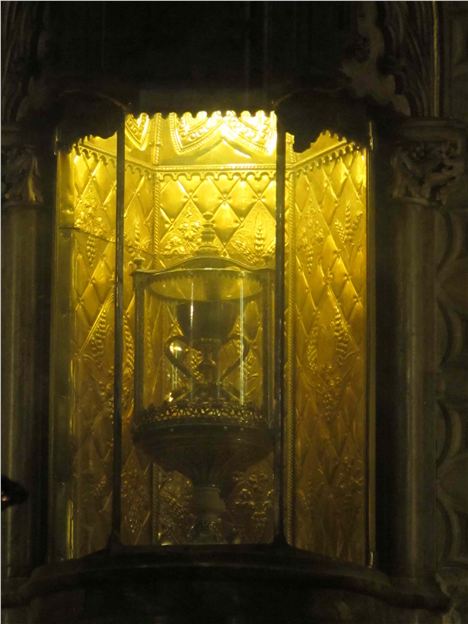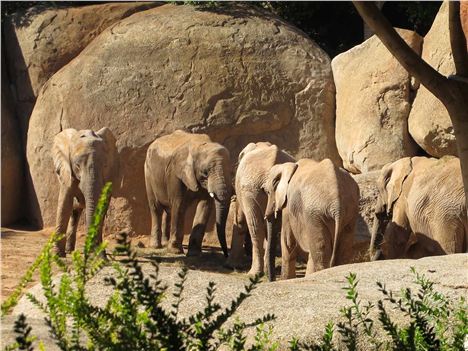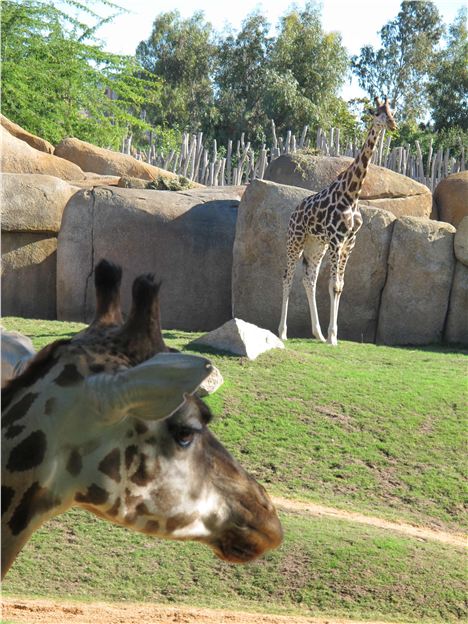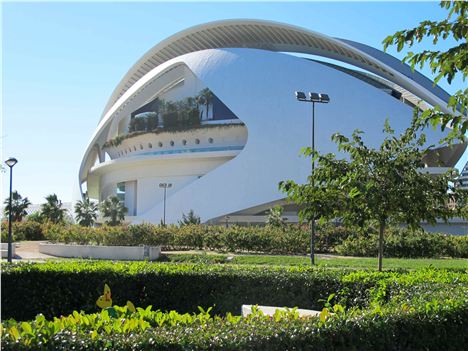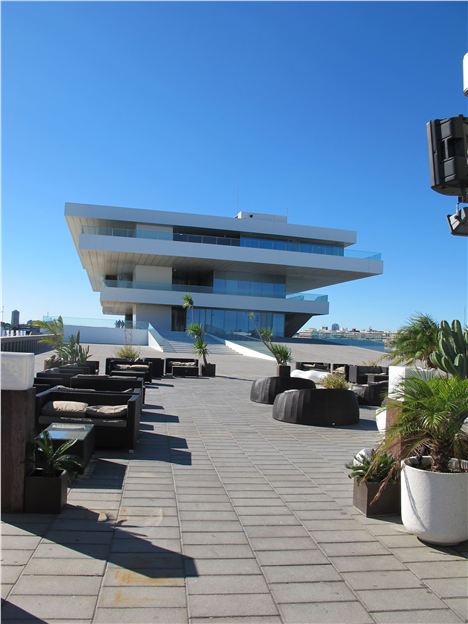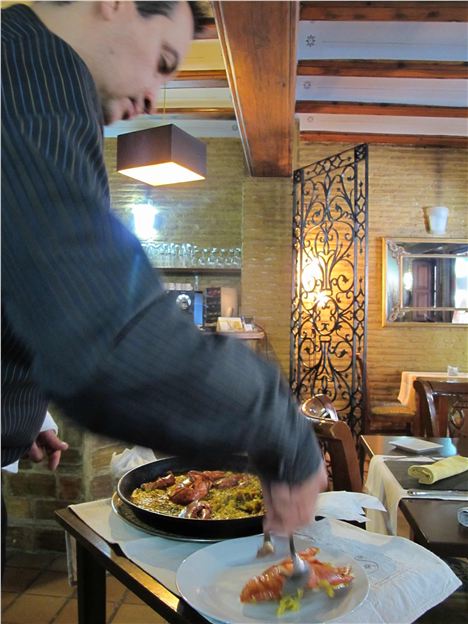A BIG green parrot and a self-abusing gargoyle – it pays to gaze up at the rooftops in Valencia, a city of many surprises.
The BGP is a weather vane teetering on a golden ball on the dome of the Mercado Central. Cotarro means parrot in Spanish but also chatterbox, aptly symbolising the teeming meeting place that is the great food market 50 metres below.
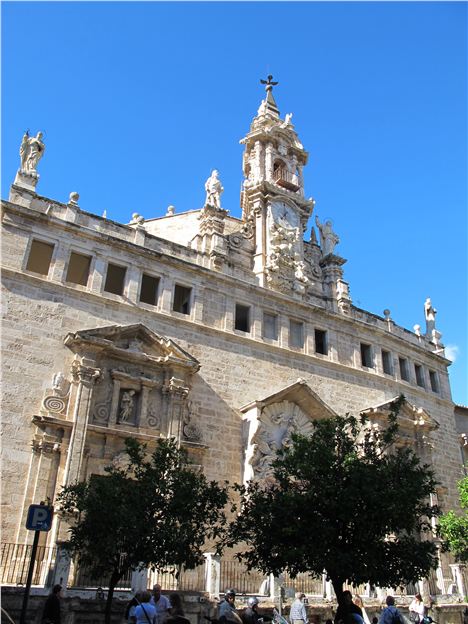 Lonja De La Seda – The Silk Exchange
Lonja De La Seda – The Silk Exchange
The gargoyle, flagrantly flaunting his stone todger (no, I don’t know the Spanish equivalent), is a warning against the sins of onanism stuck on a corner of the “Lonja de la Seda” across the road. This Gothic Silk Exchange, a UNESCO World Heritage site, all pillars and panels, is one of Valencia’s treasures. There are many others, most more modest – in all senses.
Take the Horchata. New York hipsters Vampire Weekend wrote a song about the creamy beverage. “In December drinking horchata; I’d look psychotic in a balaclava.” I suspect they were imbibing the Latin American variant, which substitutes almonds and the like for the tigernuts of the Valencian original.
 Horchata; below, the exterior of the benchmark horchateria we visited
Horchata; below, the exterior of the benchmark horchateria we visited
Tigernuts, or Chufa, aren’t even nuts – just the edible tuber of a cultivated sedge first made into a sugary milkshake-like drink here by the resourceful Moors centuries ago. It grows in the Albufeira wetlands 20 minutes to the south of the city alongside the rice perfect for Paella, another more famous culinary treat Valencia calls its own.
In truth, despite partaking of it in THE place, the Horchateria de Santa Catalina with its extravagant tiling, it wasn’t love at first taste, or second. It was the same with Paellas until our final, brilliant one. This was a luxury version, eschewing scraggy rabbit and meagre prawns of the cursory offerings in favour of a whole lobster. That was at Chust Godoy, a traditional restaurant next door to our hotel in the Ciudad Vieja (Old Town).
 Valencia's Central Market; below, its spectacular dome and assorted stalls
Valencia's Central Market; below, its spectacular dome and assorted stalls
There should be no excuse to eat badly in this town. The Mercado Central, built in lavish Modernista style early last century, covers an area of 8,000 square metres. Outside ferreterias peddle paellas (the shallow cast-iron pan from which the rice dish gets its name) from one-person to vast family versions. Not recommended for getting through Ryanair checkout.
The market’s central dome is decorated with stained glass oranges and lemons, celebrating a further unfair Valencian culinary advantage. Down below the riches of the sea, including live eels, compete with the kind of offal and body parts displays we never see back home.
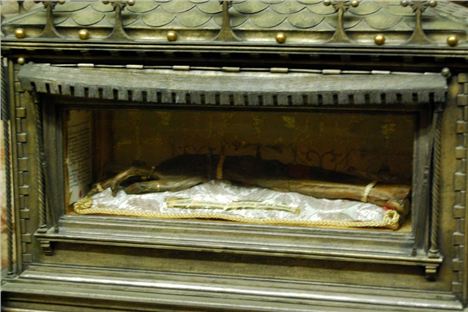 Withered arm of St Vincent in the Cathedral
Withered arm of St Vincent in the Cathedral
Which takes me to the Withered Left Arm of St Vincent in the nearby Cathedral museum. Inside its glass case the martyr’s “brazo incorrupto” still sports rings on his preserved fingers. Less gory is the Holy Grail – yes, THE Holy Grail, a gold and agate cup said to be used by Jesus at the Last Supper, which survived through the Dark Ages in a monastery in Aragon.
 Goya in Valencia Cathedral; below, the Holy Grail
Goya in Valencia Cathedral; below, the Holy Grail
Weirder than both is one of two Goyas in the Cathedral, detailing an exorcism. The naked corpse was painted over with clothes after the great painter’s death.
It’s a relief after this sombre stuff to mount the Micalet or Miguelete, the unfinished 14th century Cathedral tower, and take in terrific views over the city and its many blue-roofed churches.
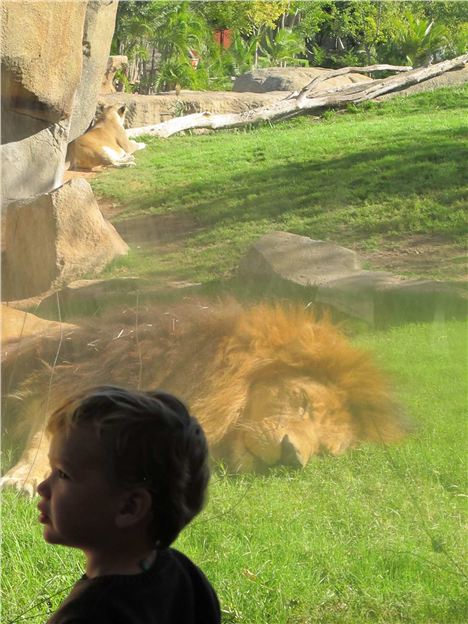 Bioparc – Child with slumbering lion; elephants and giraffes
Bioparc – Child with slumbering lion; elephants and giraffes
The most striking aspect of the cityscape is the Turia Gardens, former riverbed that sweeps down 9km almost to the sea. The River Turia was diverted after devastating floods in 1957. The old stone bridges still cross a verdant space that is home to cycle paths, all-weather football pitches and a children’s playground with a huge fibreglass model of Gulliver. But it is the spectacular attractions at either end that take the breath away.
Bioparc Valencia is an example of “zoo immersion” – allowing visitors to experience wild animals in recreated natural habitats. Across 250 acres of reclaimed urban landscape they do this by reducing awareness of barriers and recreating ecosystems (sometimes artificially by piping bird sounds through speakers – captivated school parties didn’t seem to mind). The park is completely eco-friendly, too, with 95 per cent of its water recycled and heated by the vast solar panels throughout the lush parkland.
At the other end of Turia is a very different habitat created by Valencia’s favourite son, the architect Santiago Calatrava – ManCon readers will know him from his Trinity footbridge near the Lowry Hotel.
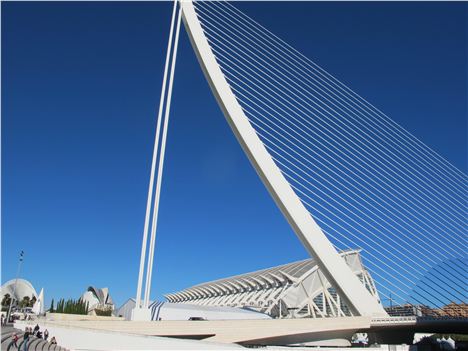 City Of Arts And Sciences by Calatrava; below Palace of Arts and walkway
City Of Arts And Sciences by Calatrava; below Palace of Arts and walkway
The Ciudad de las Artes y las Ciencias (City of Arts and Sciences) is far more spectacular. Just look at my pictures. In a futuristic park setting you get a palace of the arts, IMAX cinema, impressive interactive science museum and, my favourite, El Oceanografic, Europe’s largest aquarium.
Each Oceanografic building is identified with the following aquatic environments: the Mediterranean, Wetlands, Temperate and Tropical Seas, Oceans, the Antarctic, the Arctic, Islands, and the Red Sea, alongside the Dolphinarium with 24 million litres of water and a depth of 10.5 metres.
 Not all El Oceanografic's inhabitants are lookers
Not all El Oceanografic's inhabitants are lookers
During their route through the various installations, visitors can get to know at first hand the behaviour and way of life of over 45,000 individuals of 500 different species: dolphins, belugas, walruses, sea lions, seals, penguins, turtles, sharks, rays, sawfish, jellyfish, starfish, sea urchins, and crustaceans – as well as wetland bird species.
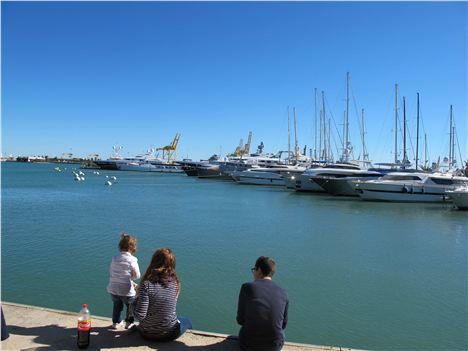 Royal Marina and, below, nearby Veles y Vents viewed from the seafront bars
Royal Marina and, below, nearby Veles y Vents viewed from the seafront bars
It’s only a short tram ride away from Valencia’s airy palm-fringed Las Arenas beach, reached via the port with its Royal Marina and Americas Cup legacy and British architect David Chipperfield’s iconic Veles y Vents building. I say, iconic. I’m not really sure what it’s for, but it looks cool viewed through a beer glass from the parade of marina front bars.
The old Valencia is equally captivating, especially the streets radiating out from the Plaza del Virgen into the bohemian Barrio Carmen. The edgier multi-cultural Ruzafa quarter to the east beyond the gorgeous Colon Market (upmarket boutiques) is challenging its allure but is not quite there yet
On the edge of Carmen is a bar I highly recommend. The Cafe del Duende is an intimate, unpretentious flamenco venue – far removed from the tacky showbiz versions. The night we were there a thrilling dancer, hypnotic guitar player and a cante jondo singer with real passion gave us an authentic timeless Spanish experience.
A bit like our eye-opening long weekend in Valencia.
Some recommended places to eat and drink in Valencia:
La Salvaora, Calle Calatrava 19, 460011. Narrow, bright bar whose walls are covered in more than 200 images portraying the history of flamenco. Their take on tapas is thoroughly contemporary, though, with flashes of vivd innovation and a raft of interesting local wines by the glass to accompany. www.lasalvaora.com/index_ingles.html
Chust Godoy, Calle Boix 6 www.chustgodoy.com
La Pilareta, Moro Zeit 13, Crowded, atmospheric tapas joint, just off the vibrant Plaça del Tossal. Mussels are their specialty, but also try the spicy “habas” beans, another Valencian tradiiton. The waiters will sing out your order to the kitchen, in keeping with the tradition of old tapas bars.
El Huerto, Calle Pedro III El Grande 11. Location, location, location plus excellent local dishes in a 19th century palace. www.elhuertorestaurante.es
Seu Xerea, Almovodar 4. Upper-end Med fusion restaurant run by Steve Anderson, a former London physics teacher resident in Valencia for two 20 decades. Signature dish: crunchy crayfish with celeriac remoulade. www.seuxerea.com/en
Central Bar by Ricard Camarena, Mercado Central, Puesto 105 -131, Plaza del Mercado 46001. Affordable tapas-style dishes from Michelin-starred chef’s latest outlet. www.centralbar.es
Cafe de Madrid, c/de la Abadía de San Martín 10, Old-fashioned two-floor haunt is considered the birthplace of Agua de Valencia, a cocktail made from a base of cava or champagne, orange juice, vodka and gin.
Café de las Horas, Conde de Almodóvar 1 Gaudy fin de siecle feel to this gay-friendly bar with a gurgling fountain and a marble bar. Good cocktails including chilled jugs of Agua de Valencia. Good coffee, too.
www.cafedelashoras.com
 Camp it up – Cafe de Las Horas
Camp it up – Cafe de Las Horas
Fact file
Getting there:
Ryanair resumes flights from Manchester to Valencia at the end of March 2013. To book, visit www.ryanair.com
Getting around:
Valencia Card. free public urban transport and discounts in museums, leisure activities, shops and restaurants. 24h 15€, 48hr 20€, 72hr 25. 10 per cent off if booked online. www.valenciatouristcard.com/es/que-es
Valencia tourism information: www.turisvalencia.es
What to see:
Bioparc www.bioparcvalencia.es/en/
Oceanografico www.cac.es/oceanografic/
National Ceramics Museum, Poeta Querol 2. http://mnceramica.mcu.es
IVAM Contemporary Art Museum, Calle Guillem de Castro 118 www.ivam.es
Flamenco at Cafe del Duende, c/Túria 62 www.cafedelduende.com
Ruzafa guide www.livingruzafa.com
Las Fallas de San Jose. Every March for five days, one of Spain’s biggest fiestas culminating in the wild Nit de Foc when grotesque cardboard and wooden figures of celebs are burned on huge bonfires. Link
Staying there:
Ad Hoc Monumental Hotel. 28 minimalist but chic rooms in a restored 19th century brick building, a five-minute walk from the Plaza del Virgen. Carrer de Boix, 4, Valencia, 46003 Spain www.adhochoteles.com/monumental/EN/index.asp
Manchester Airport Parking
VIP Valet – drop and collect your car right next to the terminal and get fast tracked through security. Your car is parked on site.
Meet and Greet – drop your car off with staff next to the terminal and collect on your return. Your car is parked on site.
Multi-storey car park at T1, 2 and 3 – ultra-convenient multi-storey car parking right next to the terminal. Park and walk under cover to reach the terminal.
Long stay car park at T1, 2 and 3 – ground surface car park offering free, regular 24 hour bus transfers direct to the terminal.
Shuttle Park – secure parking at great rates for cost-conscious travellers. Free, regular 24 hour bus transfers direct to the terminal.
JetParks – low-cost parking option run by Manchester Airport, fully manned 24/7, parking from £2.99 per day. Visit this link









